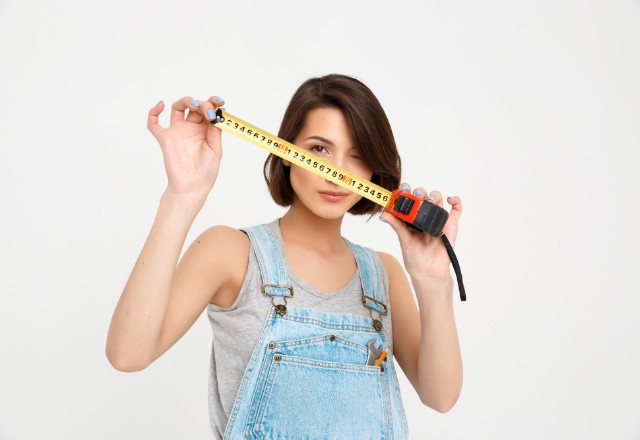If you’re a homeowner looking to replace your vinyl siding, then it’s important that you take the time to measure accurately. This can save you time and money in the long run, as getting an accurate measurement will ensure that your new siding fits perfectly. In this article, we’ll walk you through the steps of measuring vinyl siding for replacement so that you can be sure that your project is successful. From tools to tips and tricks, by the end of this article, you’ll know exactly what it takes to master the art of measuring vinyl siding for replacement. So let’s get started!
Disclaimer: The information provided in this article is for informational purposes only and does not constitute professional advice. While every effort has been made to provide accurate and up-to-date information, we strongly suggest that you consult a professional before undertaking any project or making any changes to your home. For individual consultations and advice, we recommend that you contact Advance Roofing LLC at advanceroofingllc.com; they are always happy to help! Plus, Advance Roofing LLC has proudly provided Spokane, WA with the highest quality roofing services for many years.
What is Vinyl Siding Replacement?
Vinyl siding replacement is a process of removing old and damaged vinyl siding from a house or building and replacing it with new vinyl siding. The vinyl siding serves as a protective covering for the exterior of a building and helps to enhance its aesthetic appeal. It is a task that requires precision and attention to detail to ensure that the replacement siding aligns and fits accurately. It is essential to measure twice and replace once to avoid costly errors and irreversible actions. In this article, we will explore the art of measuring vinyl siding for replacement, to help you plan and execute your project seamlessly.
Tips for Making Accurate Measurements for Vinyl Siding Replacement

If you’re considering replacing your vinyl siding, accuracy is essential for a successful project outcome. One of the most important rules to keep in mind is to measure twice and replace once. Poor planning and a mistake in measurement can result in costly errors that can set back the project timeline.
To ensure accurate measurements, it’s important to plan ahead. Before beginning the measurement process, remove any obstacles that may hinder the accuracy of your measurements. This can include debris, outdoor furniture, or window screens. Having a clear workspace will make it easier to take measurements and avoid errors.
When it comes to measuring tools, having a piece of wood can be extremely helpful. A long piece of wood can be placed next to the siding to measure the distance between the top and bottom points. Using a piece of wood allows for more accurate measurements, as it provides a sturdy base to measure against.
When taking measurements, it’s important to take bearings from the highest to the lowest point of the siding. This not only provides more accurate measurements but also ensures that the siding will fit perfectly when it comes time for installation.
Ultimately, accuracy is the key to success when it comes to vinyl siding replacement projects. Taking the time to plan ahead, remove obstacles, and use proper measuring tools like a piece of wood, will result in a more accurate and successful project outcome. So, remember to measure twice and cut once to avoid costly mistakes and ensure a smooth and successful vinyl siding replacement project.
Tools for Measuring Vinyl Siding for Replacement
Accurate measurements are crucial when it comes to replacing vinyl siding. Without precision, costly errors can occur during installation and result in an uneven finish. Fortunately, there are tools and techniques available to help ensure that your measuring process is done correctly. In this article, we’ll explore some of the best tools for measuring vinyl siding for replacement.
Measuring Tape or Ruler

When it comes to replacing vinyl siding, accurate measurements are crucial for a successful installation. Measuring tapes and rulers are essential tools for taking accurate measurements, but it’s important to use the right type of device for the task at hand.
Measuring tapes are commonly used for measuring longer lengths of siding, such as the height or length of a wall. They come in varying lengths, with 25 feet being the minimum recommended length for measuring vinyl siding. This ensures that the entire length of the siding can be measured accurately, without having to move the tape multiple times.
When selecting a measuring tape, it’s important to choose one with clear and easy to read markings. The tape should also be sturdy enough to avoid stretching or breaking, which could result in inaccurate measurements.
On the other hand, rulers are ideal for measuring smaller lengths of siding, such as the width of a single piece. Rulers should be at least 6 inches in length to accommodate most standard sized siding pieces. They should also have clear and precise markings to ensure accurate measurements.
Using measuring tapes and rulers is a straightforward process. Simply place the tape or ruler along the area to be measured and read the markings to determine the length or width. It’s important to double-check measurements to ensure accuracy, taking measurements from multiple spots to account for any inconsistencies in the surface.
Levels and Squares

When it comes to measuring vinyl siding for replacement, using levels and squares is absolutely essential. These tools help ensure that the siding is evenly aligned and perpendicular, which is crucial for achieving an attractive and professional-looking installation.
A level is a tool that is used to determine if something is horizontally level or aligned. This is important for ensuring that the siding is installed in a straight line along the wall. Using a level is quite simple – just place the tool on a flat surface and use the bubble vial to ensure that it is straight. This will help ensure that the horizontal lines of your siding are even and straight.
Meanwhile, a square is used to determine if two adjacent sides are perpendicular to one another. This is important for ensuring that the siding is installed at 90-degree angles at corners and edges. To use a square, simply place it at the corner of the siding to ensure proper perpendicularity. This ensures that the corners of your siding are square and aligned properly.
Using a chalk line can also be helpful in ensuring straight lines and proper alignment. This tool allows you to mark a straight line on the wall, which can then be used as a guide for installing the siding. By making sure that your lines are straight and aligned, you can be confident that your project will look professional and polished.
Preparing to Measure for Vinyl Siding Replacement
Before beginning any siding replacement project, it’s important to understand the importance of proper measurements. Making costly errors due to poor planning can lead to irreversible actions and can end up costing you more money in the long run. Upfront planning and preparation can help ensure a successful project outcome. In this article, we’ll discuss how to properly prepare to measure for vinyl siding replacement.
Taking Accurate Measurements of Existing Siding Lengths
When replacing vinyl siding, taking accurate measurements of existing siding lengths is essential to ensure a smooth and successful replacement process. To master the art of measuring vinyl siding for replacement, it is important to follow a few key steps.
First and foremost, it is crucial to start with a clean and dry surface. Any debris or moisture on the existing siding can skew measurements and lead to costly errors down the line. Once the area is clean and dry, identify the starting point for measurement, typically at a corner of the house.
Next, measure the length of one siding piece from end to end, making sure to measure to the nearest eighth of an inch for greater precision. Repeat this process for all siding pieces, including door and window trim, and make note of any variations in length. Taking accurate measurements of door and window trim is especially important as these pieces may require custom sizing to ensure a perfect fit.
By measuring each piece of existing siding to the nearest eighth of an inch and including door and window trim in the measurement process, upfront planning can help avoid the need for costly mistakes and revisions later on. This step is especially important during the planning phase of projects, and can be a key aspect of project and change management.
In addition to measuring each piece of existing siding, it is also important to make a measurable action plan and to double-check measurements before making any irreversible actions during the replacement process. This diagnostic decision-making process can help ensure that the project progresses smoothly, mitigating project risks and ensuring positive client outcomes.
By prioritizing accurate measurements during the planning phase of vinyl siding replacement projects, and including key project team members such as project managers, engineering reviews, and internal reviews, amazing things can be achieved using even the most basic technology, especially for prospective clients who appreciate a client experience obsession. With the practice of measure twice, replace once, it is possible to master the art of measuring vinyl siding for replacement, with no more fear of funny measure or paper measure mishaps, and with exact measurements leading to handmade pieces of high-quality vinyl siding replacement, free from sharp pieces and other issues that can arise from poor measurements.
Record Accurate Measurements on Paper or a Digital Device

By utilizing a record-keeping system, you can avoid the risk of losing information and have easy access to your measurements throughout the project. When recording measurements, make sure to label each section and indicate whether the measurement is the length or width. This will help you keep track of each piece and ensure that everything is properly aligned.
Recording measurements on paper is a simple and cost-effective way to keep track of your data. You can use a ruler or tape measure to measure each piece of siding, write it down on paper, and label it accordingly. However, it is important to keep your paper records organized and in a safe place to avoid misplacing them.
On the other hand, recording measurements on a digital device, such as a tablet or smartphone, provides the added benefit of not having to worry about losing your records. There are several measurement-keeping apps available that can help you track your information and provide easy access to your data throughout the project.
Regardless of whether you choose to record measurements on paper or a digital device, accuracy is key. Taking precise measurements of the length and width of each piece of siding will ensure that your replacement project progresses smoothly, mitigating project risks, and ensuring positive client outcomes.
Removing Old Vinyl Siding Before Installing New Pieces
Before installing new vinyl siding, it is important to first remove any old or damaged pieces. Here’s a step-by-step guide on how to properly remove old vinyl siding:
- Identify the areas of the siding that need to be replaced. This may involve inspecting the entire house or only specific areas where damage has occurred.
- Use a pry bar to carefully remove the existing pieces of siding. Be sure to start at the top and work your way down, removing each piece in order.
- Make sure to remove any nails or staples holding the siding in place. Use a hammer or nail puller to extract any remaining fasteners.
- To avoid damaging nearby pieces of siding, it may be helpful to use a zip tool to unhook the interlocking pieces of siding. This tool can be used to separate the interlocking parts of the siding, allowing for easier removal.
- Once the old siding is removed, inspect the area for any damage or rot that needs to be repaired before installing new siding. This may involve replacing any damaged or rotted wood underneath the siding to ensure a solid foundation for the new siding.
- Finally, clean the area of any debris or residue before moving on to installing the new pieces. This will ensure a clean surface for the new siding to adhere to.
Following these steps will help ensure that any old or damaged vinyl siding is properly removed before new pieces are installed, resulting in a clean and durable finished product.
Installing New Pieces of Vinyl Siding in Place of Old Ones

Replacing old and worn-out vinyl siding can enhance the appearance of your house and protect it from harsh weather conditions. If you want to replace old siding with new, fresh vinyl siding, here is a step-by-step guide to help you get started.
- Remove the Old Siding: Before you begin the installation process, remove the old vinyl siding carefully. Follow the steps mentioned in the previous section to do this. This will create a clean surface for installing new pieces of vinyl siding.
- Install New Trim: Before installing the new vinyl siding, it is essential to install new trim. This step is crucial in providing an even and level surface for the siding to lay on. Begin by measuring and cutting the new trim to the appropriate size. Install the trim using the correct fasteners. Ensure that the trim is level and vertical. If the trim is not installed correctly, it can affect the entire look of the house.
- Measure and Cut the New Siding: Once you have installed the new trim, you need to measure and cut the new pieces of vinyl siding. To do this, measure the length of the area where the siding will be installed. Ensure that you leave some extra length for overlapping. Measure and cut the new pieces of siding to the correct size using a vinyl cutting tool.
- Attach the Siding to the House: Now that you have measured and cut the vinyl siding, it is time to attach it to the house. Start at the bottom of the wall, and attach the new pieces of siding one-by-one, ensuring that they are level and straight. Use the appropriate nails or clips to install the vinyl siding. Avoid over nailing as it can cause the siding to buckle.
- Ensure the Siding is Properly Secured and Sealed: Finally, make sure the vinyl siding is properly secured and sealed. Check that each piece of vinyl siding is interlocked together correctly. Use sealant around the windows and doors to prevent water from getting in behind the siding.
Installing new pieces of vinyl siding in place of old can be a lengthy process. However, following the steps mentioned above, you can replace your old siding and enhance the aesthetic appeal of your house, while also protecting it from harsh weather conditions.
Conclusion
Measuring vinyl siding for replacement can seem daunting at first, but with the right tools and a few helpful tips, you’ll be able to measure accurately and easily. With an accurate measurement, you can ensure that your new siding fits perfectly and looks great. So take the time to measure twice and replace once, and you’ll be sure to have a successful home improvement project.



 509-201-4190
509-201-4190
